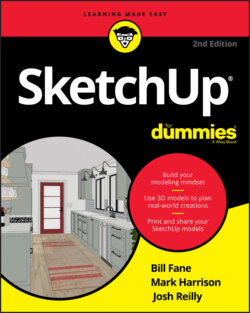Читать книгу SketchUp For Dummies - Mark Harrison - Страница 55
Selecting what you mean to select
ОглавлениеIf you want to move, rotate, copy, scale, or otherwise manipulate existing geometry in your model, you need to select it first. Your selection tells SketchUp what geometry you want to change.
To select things, you use (drum roll, please) the Select (E) tool, which looks exactly the same as the Select tool in every other graphics program on the planet: It’s an arrow. That’s a good thing, because selecting isn’t the sort of thing you should have to relearn every time you pick up a new program. Here’s everything you need to know about selecting things in SketchUp:
Technically, every single thing you see in your modeling window is an entity. SketchUp has three kinds of entities:Elements are basic pieces of geometry, like edges and faces.Objects are made up of elements. Components and groups, which we cover in Chapter 5, are objects. Anytime you want to make a separate thing with its own name and metadata, you make an object. In SketchUp, objects are everywhere.Annotations are things like text, guides, dimensions, and section planes. Annotations is kind of a catch-all category; anything that isn’t an element or an object is an annotation.
Click anything in your model to select it — while you’re using the Select (E) tool, of course.
To select more than one thing, hold down the Shift key while you click all the things you want to select. The Shift key works both ways when it comes to the Select (E) tool. You can use it to add to your set of selected things (as we mention earlier), but you can also use it to subtract something from your selection. In other words, if you have a bunch of stuff selected, and you want to deselect something in particular, just hold down Shift while you click it; it isn’t selected anymore.
Selected entities in SketchUp look different depending on what they are:Selected edges turn blue.Selected faces change from plain gray to blue-gray (if you’re using the default style).Selected groups and components have a blue box around them.Selected annotations turn blue.
A much fancier way to select things in your model is to double- and triple-click them. When you double-click a face, you select that face and all the edges that define it. Double-clicking an edge gives you that edge plus all the faces that are connected to it. When you triple-click an edge or a face, you select the whole conglomeration that it’s part of. See Figure 3-18.
You can select several things at the same time by dragging a box around them. You have two kinds of selection boxes; the one you use depends on what you’re trying to select (see Figure 3-19):Window selection: If you click and drag from left to right to make a selection box, you create a window selection. In this case, only things that are entirely inside your selection box are selected.Crossing selection: If you click and drag from right to left to make a selection box, you create a crossing selection. With one of these, anything your selection box touches (including what’s inside) is selected. The Window selection box (left to right) is shown using solid lines, while a Crossing box (right to left) uses dashed lines.
Just because you can’t see something doesn’t mean it isn’t selected. Whenever you make a selection, it’s a very good idea to orbit around to make sure you have only what you intended to get. Selecting too much is an easy mistake to make.
FIGURE 3-18: Try single-, double-, and triple-clicking edges and faces in your model to make different kinds of selections.
FIGURE 3-19: Dragging left to right selects everything inside your selection box. Dragging right to left selects everything that your selection box touches.
